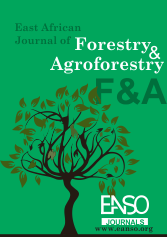Urban Consumption of Charcoal and Its Implications on Deforestation in Puntland, Somalia
Abstract
Slow-growing Acacia species, such as A.bussei and A.nilotica, constitute the main part of the woody vegetation and the backbone of economic activities in the dryland ecosystems of Puntland state, Somalia. These trees are the most important, if not the only, customary source of energy for the whole Somali population to meet their household cooking needs. Charcoal manufacturing and use are often claimed to be a major threat to maintaining a tree cover on drylands, especially when these activities are linked to national and international trade, as is the situation in Puntland. The main aim of this study was to analyse the effect of urban charcoal consumption on forest loss in Puntland. Another aim was to contribute to new policy and management recommendations in order to alleviate the pressure on forest and tree resources and to diminish the dependency on energy derived from charcoal. The present results show that the average kiln efficiency in charcoal production was around 20%. In the urban household surveys conducted in four towns, the mean per capita consumption was found to be between 2.7 and 4 sacks, corresponding to 63kg and 93kg per person and year, respectively. There was significant variation in charcoal consumption between the four towns studied (Garowe, Burtinle, Bossaso and Galkayo), with Garowe consuming significantly less than the other three towns. This disparity renders further studies on ways to increase energy efficiency important. Assuming that 95% of the population of Puntland relies on charcoal, the total area of acacia forest cleared every year in the state for charcoal production purposes can be estimated to be 2,400 ha. In order to attain sustainable management in its forests and woodlands, Puntland should increase its woody vegetation cover and develop a monitoring system for its forest and tree resources based on new scientific research. Similarly, to other countries in the Horn of Africa region, Somalia and the Puntland state, as part of it, must find a balance between conserving tree resources and supplying wood fuel. However, an ultimate solution requires observing the specific local conditions. Additionally, policies should be established that contribute to improvements along the whole wood energy value chain. Such policies can guide the management of natural and planted forests to rural communities, state agencies and the private sector. Similar guidance is needed for wood harvesting and utilisation, especially paying attention to kiln and cooking stove efficiency and alternative energy sources. This would profoundly change the present situation in which the charcoal used in the state comes exclusively from natural, unmanaged forests and woodlands. Alternative potential sources for household energy are LPG, kerosene and solar energy, but their wider use also necessitates research and development in a participatory way
Downloads
References
Bailis, R., Ezzati, M., Kammen, D., (2005). Mortality and greenhouse gasimpacts of biomass and petroleum energy futures in Africa. Science308, 98–103.
Boberg, J. (1993). Competition in Tanzanian woodfuel markets.EnergyPolicy, 474–490.
Bolza, E. & Keating, W.G. (1972). African timbers: the properties, uses and characteristics of 700 species. Division of Building Research, CSIRO, Melbourne, Australia. 710 pp. http://www.worldagroforestrycentre.org/resources/databases/agroforestree
Byer, T., (1987).Review of Household Energy Issues in Africa, BankInternal Memorandum. World Bank, Washington, DC.Centre for Energy, Environment, Science and Technology (CEEST),
Chidumayo, E.N. (1991). Woody biomass structure and utilization for charcoal production in a Zambian miombo woodland. Bioresource Technology 37, 43–52
FAO (1971). Tanzania: Present Consumption and Future Requirements of Wood in
Girard, P. (2002). Charcoal production and use in Africa: what future? Unasylva 211, 30–34.
Hall, D.O., Moss, P.A. (1983). Biomass for energy in developing countries.GeoJournal 7, 5–14.
Hofstad, O., (1997). Woodland deforestation by charcoal supply to Dar-esSalaam. Journal of Environmental Economics and Management 33, 17–32.
Hosier, R.H., Milukas, M.V., (1992). Two African woodfuel markets: urban demand, resource depletion, and environmental degradation. Biomass and Bioenergy 3, 9–24.
Hosier, R.H., Kipondya, W., (1993). Urban household energy use inTanzania: prices, substitutes and poverty. Energy Policy 454–473.
IUCN (2006). Country Environmental Profile for Somalia Eastern Africa Regional Office P.O. Box 68200-00200 Nairobi, Kenya Tel: +254 20 890605-12 Fax: +254- 20 890615 Email: earo@iucn.orgKamweti, D.M. (1984). Fuelwood in Eastern Africa: Present Situation and Prospects.
F. Kilahama, (2005) “Impact of Increased Charcoal Consumption to Forest and Woodlands in Tanzania,”. http://www.coastalforests.tfcg.org/pubs/Charcoal&Forests.pdf
Kammen, D.M., Lew, D.J., (2005). Review of technologies for the production and use of charcoal. Renewable and Appropriate Energy Laboratory Report, 1 March 2005.
Mnzava, E.M. (1981). Village industries vs. savanna forests.Unasylva 131, Article 6.
Malagnoux, M. (2008). Restauration des terresarides dégradées pour la production agricole, forestièreetpastoralegrâce à une nouvelle technique mécanisée de récolte des eauxpluviales. In C. Lee & T. Schaaf, eds. The future of drylands, Proceedings of the International Scientific Conference on Desertification and Drylands Research, Tunis, Tunisia, 19–21 June 2006. Dordrecht, the Netherlands, Springer. (In press
Mwampamba, T.H., (2007). Has the woodfuel crisis returned? Urban charcoal consumption in Tanzania and its implications to present and future forest availability, Energy Policy 35; 4221 – 4234.
Reyes G, Brown S, Chapman J, Lugo AE (1992). Wood Densities of Tropical Tree Species. United States Department of Agriculture. Forest service. Southren Forest Experimental Station. New Orleans, Louisiana. General Technical Report SO 88.
Masoud, R.S., (1990). Fuelwood demand in Zanzibar Town and theimplications for forestry policy.Masters Thesis, Agricultural Universityof Norway, AS.
Masoud, R.S., (1991). Fuelwood use in Zanzibar Town. In: Williams, P.J.(ed), Zanzibar Forestry Development Project Technical Paper No. 3.
Regions, districts, and their populations: Somalia 2005" (PDF). UNDP.Retrieved 7 July 2015.
Robinson, A P. (1988).Charcoal-making in Somalia: A look the bay method. Overseas Development Natural Resources Institute, Oxford, UK. FAO corporate document repository. http://www.fao.org/docrep/s5780e/s5780e06.htm
The Economist (2014) A charred harvest. The unlikely link between Gulf lounges and Somalia’s
jihadists.
Tanzania. Technical Note No. 3: FAO, ROME. -II- (1981)
UNDP (2013)"Regions, districts, and their populations: Somalia ".UNDP. Retrieved 21 September 2013.
Van der Plas, R., (1995). Burning charcoal issues.Energy Issues, the World Bank Group, FDP Energy Note No. 1 /www.worldbank.org/html/fdp/enrgy/energynotes/energy01.htmlS.
Wood Energy Today for Tomorrow (WETT), (2000). The Role of WoodEnergy in Africa.Forestry Department of FAO, Rome, Italy.
Copyright (c) 2025 Abdiqani Ahmed Farah, PhD

This work is licensed under a Creative Commons Attribution 4.0 International License.




























